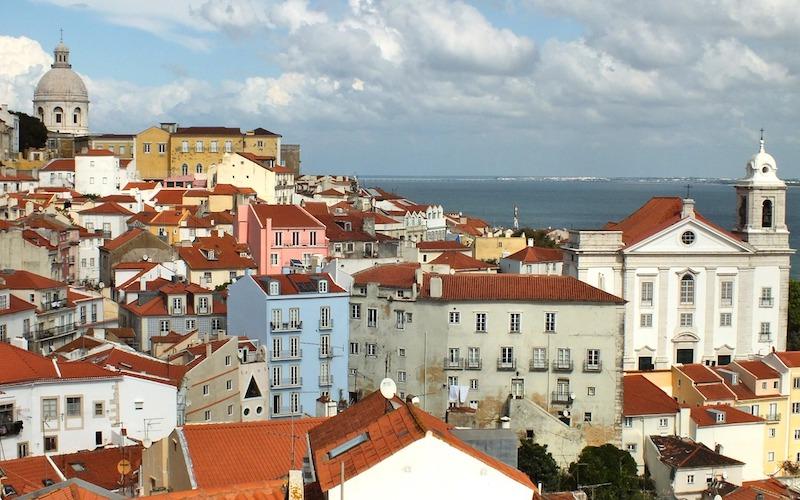4 days in Lisbon is the perfect amount of time to spend in the wonderful Portuguese capital. Rather than cramming everything into a weekend, the additional day or two will allow you to take the unforgettable day trip to Sintra and spend some time enjoying the independent bookshops and Portugese cuisine. Lisbon is one of my favourite cities in Europe, and if my hubby was to say his job could move there, I’d be packed and ready to go before you could say ‘Obrigado!’
How to Spend 4 Days in Lisbon
This 4 days in Lisbon blog is dedicated to my fabulous friends Colin and Lucy. It’s been great to have them around in Liverpool! We have shared endless hilarious travel stories and I can’t wait to hear more. Have a great time, guys!
I’ve split this blog into a nice geographically sectioned itinerary so that you to explore a different area of Lisbon each day of your trip, with a Sintra Day trip in there for the stunning Pena Palace…
- Day 1 – Castelo de Sao Jorge and Lisbon Old Town
- Day 2 – Belem
- Day 3 – Day Trip to Sintra
- Day 4 – Parque das Nações (redeveloped waterfront area) and the Aquarium
You can swap these days around as they suit you. It’s a good idea to get the 72 hour Lisbon card as this will cover all of your transport and also get you free entrance to most attractions and discounts on certain attractions. Book your Lisbon card here:
Day 1 – Castelo de Sao Jorge, Se Cathedral, Praca do Commercio and the Old Town
The first of your 4 days in Lisbon is one of the most exciting, and I’ve packed this itinerary full of the main sights that are not to be missed including Castelo de Sao Jorge, Se Cathedral and Placo do Commercio. After lunch at the Time Out Market you can then fully explore more of the Architecture and Churches in the Old Town. Highlights of Day 1:
- Castelo de Sao Jorge
- Yellow Tram Number 28
- Lisbon Se Cathedral
- Placo do Commercio
- Time Out Market
- Igreja de Santa Engrácia
- Carmo Convent Ruins
- Church of Sao Roque
- Basílica da Estrela
Castelo de Sao Jorge
The best place to start your first day in Lisbon is Castelo de Sao Jorge. This historic castle stands majestically above Lisbon giving beautiful views and is one of the finest tourist attractions in the city. The castle is entwined in Lisbon’s early history; it saw the fall of the Romans to the Visigoths, experienced the fierce conflicts between the Arabs and Christians, survived formidable sieges by the Castilians and witnessed the birth of Portugal as a seafaring nation. This varied and turbulent history is reflected throughout the castle. There are heavily fortified battlements, medieval royal quarters and seaward views, which inspired exploration within Portuguese kings.
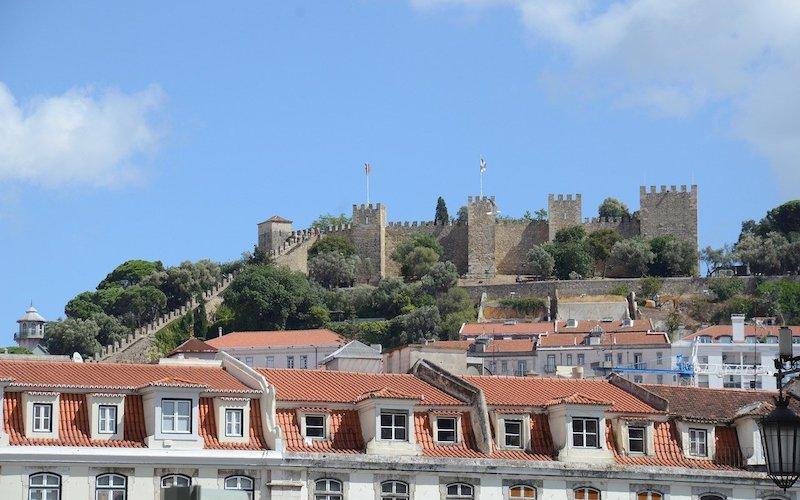
Castelo de São Jorge is an interesting tourist attraction, and this is in part due to a major restoration performed in the 1940s. The restoration project completely rebuilt the ramparts, embellished the watchtowers, and added tranquil gardens within the courtyards. The restoration may not be historically accurate, but it certainly enhances the visitor experience and provides you a lot to discover within the complex.
Number 28 Tram Journey – The Yellow Tram!
The famous number 28 tram goes through the well-known tourist districts of Alfama, Graca, Baixa and Estrela and connects Campo Ourique with Martim Moniz. If you’re following this itinerary, you can walk from Castelo de Sao Jorge to Martim Moniz and take the tram down towards the Cathedral and get off at ‘Se’.
Riding in the quaint yellow tram as it rattles and screeches through the narrow streets of the city is all part of the Lisboa experience! The lovely Remodelado trams date from the 1930s, and in pretty much any other city they would be housed in a museum, but here in Lisbon, they are a vital part of the public transport network. These historic trams are still currently in use, as the 28 route is totally unsuitable for modern trams, due to its multiple tight turns and steep gradients. A ride along the 28-tram route offers one of the best tours of the capital and is a highlight of any holiday to Lisbon. A single ticket bought onboard the tram costs about €3.00. A much-improved option is to buy the 24-hour public transport ticket, which includes all tram and bus services and the metro. This ticket costs €6.40 but annoyingly can only be purchased from the metro stations.
Lisbon Se Cathedral
The imposing and solid Se Cathedral is Lisbon’s most iconic and important religious building. From the 12th century the Se Cathedral has been entangled in Portugal’s earliest history, which are witness to the baptism, marriage and passing of Portugal’s elite and nobility. The exterior of the grand old church looks somewhat like a fortification than religious centre, with large solid walls and two impressive clock towers.
https://www.instagram.com/p/B9MVHSxHotw/
The religious sections of the cathedral are open to the public every day from 7:00 until the evening mass, held in Portuguese, at 19:00. There is no admission fee to the main cathedral, but all visitors must be suitable and respectively dressed.
The cloisters are open every day from 10:00 to 17:00 and there is an admission fee of €2.50/€1.00 (adult/child). Typical visits to Lisbon’s cathedral last between 15-20 minutes with an additional 20 minutes for the cloisters.
The Sé Lisbon is situated on the main road from Baixa to Alfama and the nearest metro station is Rossio but as I’ve mentioned, the most picturesque mode of public transport is, as mentioned, the quaint yellow number 28 tram that passes straight in front of the cathedral.
Placo do Commercio
Don’t miss the impressive Placo do Commercio – this is a massive square with symmetrical 18th Century buildings in a U-shape all around. In November of 1755 Lisbon was hit by a great earthquake followed by a Tsunami and fire which destroyed most of the city of Lisbon. King Jose I’s Prime Minister co-ordinated a massive rebuilding effort of which ‘Terreiro do Paco’ was the result. And what a result! The square came to stand for the wealth and economy of Portugal, and still does so today.
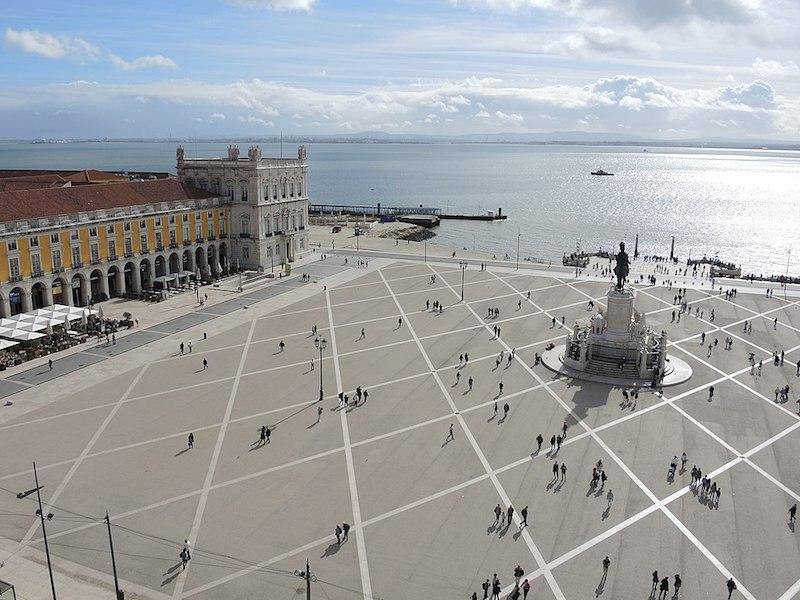
Lunch – Time Out Market
Depending on your timing and location during your exploration of the old town, you might want to tale lunch at the nearby Time-Out Market. It’s a massive food hall in Mercado da Ribeira at Cais do Sodre which is just a ten to fifteen minute walk along the sea front. You will get the opportunity to try numerous portugese delicacies, many of which seem to be curated! It is the first market in the world where everything has been chosen, tasted and tested by an independent panel of city experts from Time Out Magazine. You can then head back to the Old Town (Alfama) to complete your sightseeing for the day.
https://www.instagram.com/p/B7x1t9_H_CL/
Lisbon Old Town – Churches and Monasteries
After lunch, you will hopefully have some time to explore the Old Town area in more depth. You know that I totally love Churches and Monasteries and there are three main ones that I’d recommend for you to find – Igreja de Santa Engrácia-Panteão Nacional, Carmo Convent and the Church of Sao Roque. Of course, if you have different interests, you can very your afternoon in the Old Town accordingly.
Igreja de Santa Engrácia
The Igreja de Santa Engrácia is a 17th Century Church near the seafront which in the 20th century was converted into the National Pantheon. Today it’s used for the burial of important portugese figures. You will recognise it by the large white dome.
https://www.instagram.com/p/BY2kmOtnnzN/
If you’re into Churches (you must be a templeseeker like me!) check out the 16th Igreja de São Vicente de Fora which is in very close proximity to the National Pantheon and worth a look. Some of it was destroyed in the earthquake, but it has undergone restoration and some of the original Baroque architecture has been preserved.
Carmo Convent Ruins
A little further inland from Placo do Commercio, in the old town, be sure to find Carmo Convent – the Romantic gothic ruins that remain from the time of earthquake and tsunami of 1755 with a roofless nave. Carmo Church is now an archeological museum with it’s collections of mosaics, tombs and sanctuaries. You can get a discount with the Lisboa Card.

Church of Sao Roque
You can imagine Simon’s reaction at this point – ‘Oh look, another Church!’ But it’s the inside of the Church of Sao Roque that is impressive, so please make the effort to go in. It was the earliest Jesuit Church in the Portuguese world and one of the earliest worldwide.
If you’re still not ‘Churched-out’ then visit the Basílica da Estrela – The Beautiful Star Basilica.
Finish the Day off with a Cataplana!
One of my favourite foods to eat in Lisbon was the Cataplana – a vast array of seafoods all mixed up and cooked in a closed clam-like copper pan. If you’re looking for a great seafood place, try Cervejaria Ramiro, which was famously recommended by Anthony Bourdain.
Day 2 – Belem
Belem is the charismatic district to the west of Lisbon and is the spot for many of the city’s most iconic tourist attractions. Originally, Belem was the place of Lisbon’s docks and shipyards, and from here departed the 15th-century voyages that determined the sea routes to East Africa, India and Brazil. This rich seafaring heritage is commemorated in Belem, along with extravagant buildings that were funded by the vast wealth that flowed into Portugal from the newly discovered colonies.
For visitors, Belem is one of the best areas of Lisbon – it was my favourite part of the city. Belem boasts outstanding tourist attractions, beautiful views along the Tejo Estuary and informative museums. Belem is dissimilar to the rest of Lisbon, being filled with parks, green open spaces and tree-lined plazas, and is a breath of fresh air from claustrophobic and hectic central Lisbon.
Highlights of Day 2
- Mosteiro dos Jeronimos
- Pasteis de Belem
- Torre de Belem
- Padrão dos Descobrimentos
- Seafood along Belem waterfront
A typical visit to Belem takes half a day, but this can be easily extended to a full day by visiting the museums, taking a leisurely walk along the waterfront or joining a boat tour. As you have a full 4 days in Lisbon, I would totally recommend a full day in Belem. It is an area which can be easily explored independently and there is no need to join one of the numerous gimmicky overpriced tours. The Hop-On Hop-Off tickets are quite good for Belem if you don’t already have a Lisbon card.
Within Belem, there is plenty of restaurants and cafes, and finding somewhere for lunch won’t be an issue. Establishments closer to the waterfront or tourist attractions tend to be more expensive, for much better value try the smaller backstreets behind the Mosteiro dos Jerónimos or further to the east along the tram route.
Mosteiro dos Jeronimos
The Mosteiro dos Jerónimos is the extravagant monastery that was funded by the 5% tax levied on spices that flowed into Portugal. Originally designed as a modest monastery complex, the excessive trade wealth extended the construction by 50 years, to create one of the most ornate religious buildings of Portugal.

The monastery has a close connection to the early explorers, as Vasco da Gama spent his last night here before his epic voyage to India. Later the church was the location that sailors’ wives would come to pray for the safe return of their loved ones. The monastery is simply breath-taking, with beautiful stone carvings throughout the vast religious building, just expect long queues to get inside and arrive here early if you can.
Pasteis de Belem
The Fábrica dos Pastéis de Belém is the traditional home of the delicious Pastel de Belém custard tart (often known as Pastel de Nata) and no trip to Belem is complete without savouring one, in this loud and chaotic cafe. The Pastel de Belém was the original custard tart, and the exact recipe is a closely guarded secret. Very similar custard tarts (which are equally as delicious) produced by other bakeries are called Pastel de Natas (think along the lines of original Coca-Cola and fake coke!). So, by enjoying a Pastel de Belém, you are experiencing the original tart, which has remained consistent for over 150 years. And OMG they are DELICIOUS! (Bring me some back pleeeeeeease!!!!)
https://www.instagram.com/p/BorZV1QHU8d/
Torre de Belém
Jutting out of the water along the Belem waterfront is the instantly recognisable Belem Tower. It was built in 1521 as a defence for the mouth of the river Tagus. Take a close look at the symbolism within the architecture of the tower – the twisted rope and the Cross of the Order of Christ (a military order that financed many voyages).
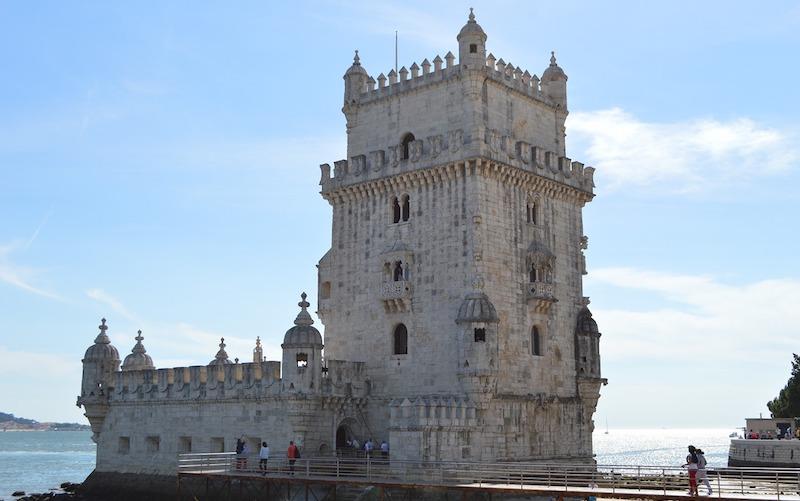
Padrão dos Descobrimentos
Along the Belem waterfront you will also find another prominent feature – Padrão dos Descobrimentos or Monument to the Discoveries. The monument was inaugurated in 1960 to commemorate the 500th anniversary of the death of Henry the Navigator.

My favourite part of this monument was the mosaic world map on the floor that you will find with a marble compass. Climb to the top of the monument and you can admire it from above!

Day 3 – A Day trip to Sintra
Sintra is a destination where an organised tour can be useful; there are steep hills separating the main attractions and a large portion of the day can be wasted waiting for public transport. We took a trip to Sintra with the Oasis Backpackers hostel and literally had one of the best days of our life! It included stopping at a nearby beach and ice-cream cafe!
Highlights of Day 3
- Travelling to Sintra by train (or tour)
- Palacio Nacional de Sintra
- Sintra Old Town
- Pina Palace
- Castelo do Mouros
- Praia da Adraga Beach
Travelling to Sintra from Lisbon
If you’re not taking an organised tour, the recommended travel to Sintra is by train, and there are two train services that depart from Lisbon. The majority of visitors depart from Rossio station as it is close to the popular tourist areas, while the Estação do Oriente station is better for visitors travelling to/from the airport. The 434-tourist bus provides an invaluable service as it connects the train station, to the Palácio da Pena and passes the historic centre and the Castelo dos Mouros. Without the bus, it is a 20-minute walk from Sintra train station to the historic centre, or a very demanding 45 minute uphill hike to the Castelo dos Mouros and Palácio da Pena. A hop-on-hop-off bus ticket for the 434 bus route costs €6.90 or a single is €3.90, and there is a departure every 15 minutes during the peak season.
Palacio Nacional de Sintra
The Palacio Nacional de Sintra (Sintra National Palace) is located at the centre of Sintra and is the first major attraction of the day. The palace has a gothic exterior and is distinctive due to the two huge coned chimneys that extend from the palace’s kitchens. This medieval palace was a favourite with the Portuguese nobility, being in continuous use from the 15th century through to the 19th century, making it the most used royal residence of Portugal.
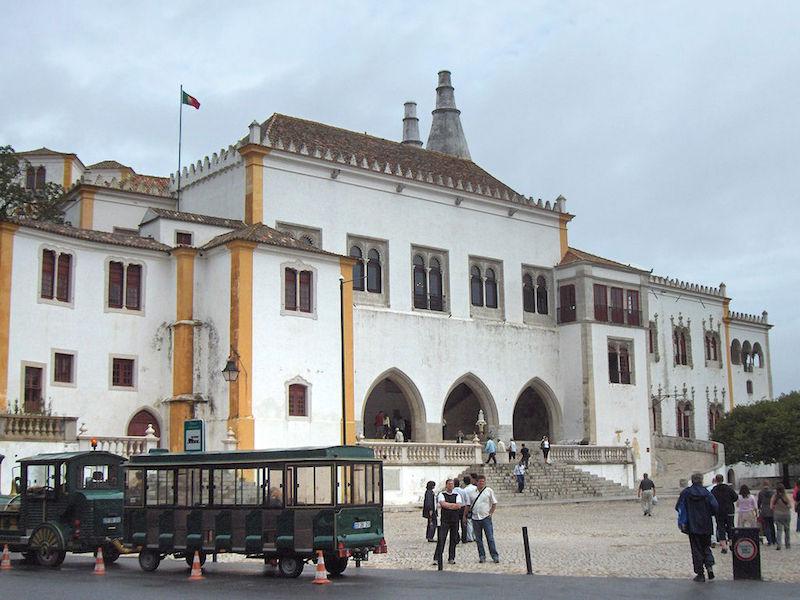
This extensive history is reflected in the varied interior, but many of the rooms follow a simplistic styling of cooling floor tiles, high vaulted rooms and beautifully painted ceilings. Highlights include the magpie room, the decretive throne room and the swan room. With a full day here, you will have time to go in. Many do half a day tour and focus on Pena Palace only.
Historic Centre of Sintra
The historic centre of Sintra is a delightful example of a Portuguese town; there are traditional painted buildings and cobbled streets filled with unique shops and family-run cafes. Highlights of Sintra include the flamboyant town hall, the busy tourist shopping streets of Rua das Padarias and the pretty church of Igreja de Santa Maria. There is a wide selection of restaurants and cafes in the centre of Sintra, and this is the best location for lunch. It is advisable to have food before heading up into the hills as there are limited and very expensive choices at the Pena Palace and Moorish castle.
Pena Palace
The next portion of the day climbs up into the hills of Sintra to visit the Castelo dos Mouros and the Palácio da Pena. For this day trip, it is not recommended to hike up the hills, as they are very steep and will waste a lot of energy and time, which is better spent exploring the main sights. It is suggested to catch the 434-tourist bus, which departs from the plaza in front of Palacio Nacional, but this is the busiest bus stop of the whole route. If you do insist on hiking up, the most scenic route goes through the grounds of the Vila Sassetti and passes the Penedo da Amizade cliffs, which are popular with rock climbers.
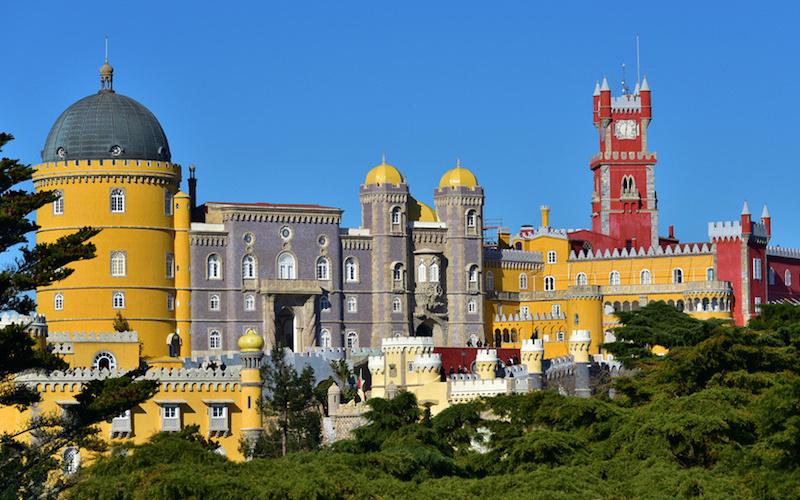
Castelo dos Mouros
The Castelo dos Mouros was constructed by the North African Moors who ruled over the region between the 8th to 11th century. After the Christian Crusades drove the Moors out of Portugal (in the 12th century), the castle had little strategic importance and was left to ruin. The castle was only restored with the construction of the Palácio Nacional da Pena (in the 19th century), as a decorative feature for the grounds of the palace. This restoration of the Castelo dos Mouros followed the ideals of the Romanticism style of architecture; with the castle intertwined with the ancient forests, and hidden paths lead to wonderful viewpoints. These wonderful views from the battlements are the main attraction for tourists, and the whole castle has a much calmer ambience than the other popular attractions of Sintra.
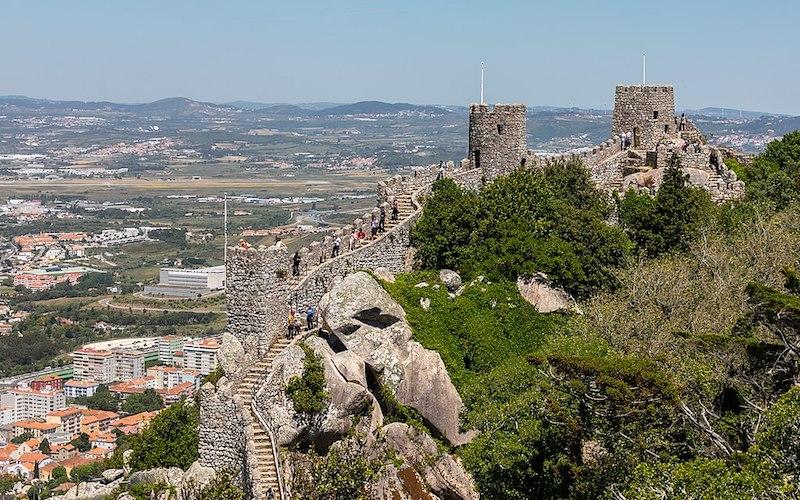
Praia da Adraga Beach
If you have time on the way back from Sintra you can stop off at Praia da Adraga Beach for some ice-cream and a relaxing walk along the beach, listening to the crashing of the Atlantic waves.
Day 4 – Museums, Parque das Nações and Beer!
You should aim to find some relaxation time during your 4 days in Lisbon and the last day should be one of the BEST! Today is all about the exciting stuff – the aquarium, the waterfront and the bars!
Highlights of Day 4
- Museums
- Parque das Nações
- Lisbon Aquarium
- Bars and Nightlife
Museums
Take the opportunity on the morning of your last day to include anything that you feel you have missed in the way of monuments and museums. There’s the Museu Nacional do Azulejo and the Museu do Oriente which you may enjoy if you like art and culture.
Parque das Nações
Personally I would recommend spending the latter half of the day in the Parque das Nações area with Aquarium, followed by an afternoon/evening of Portuguese food and drink! Parque das Nações is a redeveloped area near the Tagus river with modern architecture and a hip waterfront. This futuristic centre of Lisbon is a stark contrast to the Old Town.
You can go cycling, skateboarding and roller blading along the waterfront. It’s also got a glass-roofed entertainment centre – Centro Vasco da Gama, with shops and cinemas.
Entertainment? Check. Gambling? Check. Beer? Check.
To get there, take the metro to the stunning Oriente Station. There’s a cable car that goes from one end of Parque das Nações to the other.
Lisbon Aquarium
Lisbon’s Aquarium is the world’s largest saltwater Oceanarium and is a fantastic tourist attraction especially for families. Inside the Oceanarium there over 450 different species of animals which include sharks’ rays, penguins and even two delightful sea otters. Lisbon Aquarium was constructed as a central feature for Expo ‘98 and a decade later it is still one of Lisbon’s best family orientated tourist attractions. Lisbon Aquarium is located in the Parque das Nações district of Lisbon and is highly recommended and is regarded as one of the world’s best Aquariums. I loved the otters and the penguins!
Lisbon Aquarium is open every day between 09:00 to 18:00 and the ticket price is comparatively expensive at €15.00/€10.00/€10.00/€39.00 (adult/child/senior/family) but the exhibits are worth the fee. Typical visits last 1-2 hours but as Oceanarium is part of the larger Parque das Nações development expect to spend a half day in the area.
Try to avoid visiting the Oceanarium at the weekends during the summer season as the complex can get very busy and the busiest time of the day is just after lunch. The aquarium is only a 10-minute walk from the Oriente metro station (Red Line).
Best Bars in Lisbon
Congrats on completing 4 days in Lisbon – now is the time to sit back and relax with a beer or cocktail. The Portuguese beer we loved was Superbock, so make sure that you try one of these! There is also the traditional ‘green-wine’ to try, but it can be a bit fizzy and heavy on the stomach, so be warned!
Some of the best bars in Lisbon include Chapito, a quirky bar attached to a Circus school which has a fantastic terrace with views of the city, and Pavilhão Chinês inspired by Luís Pinto Coelho which is a warren of rooms decorated in retro seafaring memorabilia!
4 Days in Lisbon – Further Reading
I hope that you have enjoyed this blog on 4 days in Lisbon, you might also like to read my article on my Sintra day trip from Lisbon. Also check out the best restaurants in Lisbon on Tripadvisor.
If you only have three days in Lisbon, check out this 3 day Lisbon itinerary by my travel blogger friend Jorge.
However, if you have more time to spend in Portugal I would definitely consider a road trip around Portugal. Driving this small country gives you plenty of freedom and makes it easy to reach those off the beaten path destinations such as Monsaraz.

